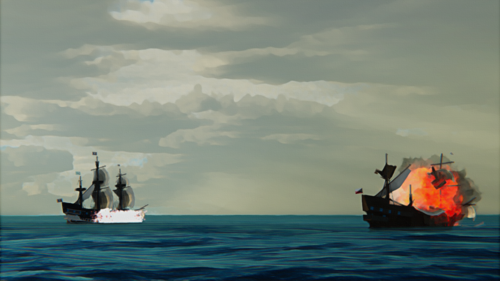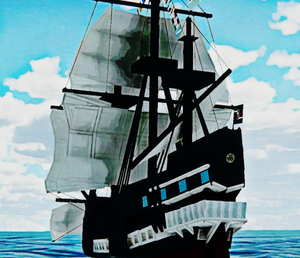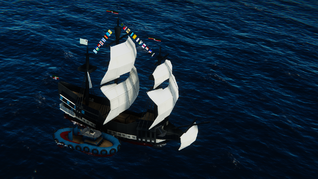ZNS Ward (IX-12)
|
ZNS Ward (IX-12)
|
|||||
|---|---|---|---|---|---|
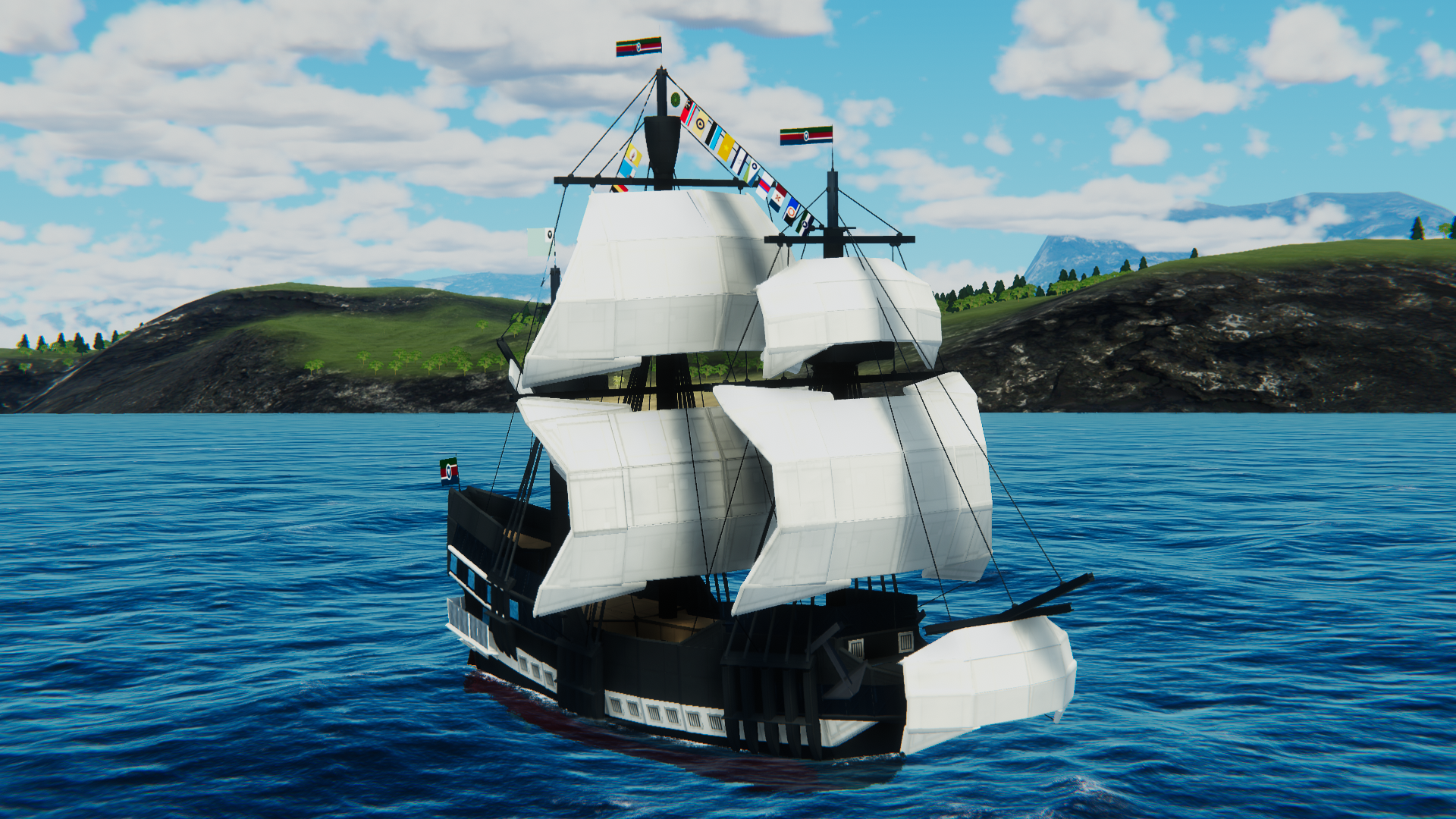 |
|||||
| ZNS Ward in full dress, 2157 | |||||
| Operation History | |||||
| Builder | John Freetowne's Shipyard, Ezekialgrad | ||||
| Laid Down | December 22nd, 1794 | ||||
| Launched | August 12th, 1797 | ||||
| Commissioned | September 4th, 1797 | ||||
| Homeport | Freetowne, Zokesia | ||||
| Status | In Active Service as of 2100 | ||||
| Vessel Characteristics | |||||
| Displacement | 132 Tons | ||||
| Length | 31.4 m | ||||
| Beam | 13.1 m | ||||
| Height | 23.3 m | ||||
| Draft | 1 m | ||||
| Propulsion | 42,000 square feet of sail | ||||
| Max Speed | 16 kn (8 m/s) | ||||
| Complement | 45 crew (4 officers, 41 enlisted) | ||||
| Armament | 24 × 24-pounder (11 kg) long gun | ||||
The ZNS Ward (IX-12), also known as Old Hickory, is a three-masted wooden-hulled heavy frigate of the Confederate Navy. She is the world's oldest commissioned naval warship still afloat. She was launched in 1797, one of ten frigates authorized for construction by the Royal Naval Act of 1794 and the third constructed. The name "Ward" was among ten names submitted to King Ezekiel V by Secretary of War Gunther Hunmbolt in March of 1795 for the frigates that were to be constructed. John Freetowne designed the frigates to be the Navy's capital ships, and so Ward and her sister ships were larger and more heavily armed and built than standard frigates of the period. She was built at John Freetowne's shipyard in the South End of Ezekialgrad, what is today Freetowne, Zokesia. Her first duties were to provide protection for Zokesian merchant shipping during the First Krakenary War and to defeat the Kraken pirates in the Second Krakenary War. ZNS Ward is most noted for her actions during the war against KRKN and the 1820 2nd Great Kolus War, when she captured numerous merchant ships and defeated three warships: KRKNS Aurora and Gemini, and TS Aontas. The battle with Aontas earned her the nickname "Old Hickory" and public adoration that has repeatedly saved her from scrapping. She continued to serve as flagship in the Schrschnell and Krakain squadrons, and she circled the world in the 1840s. During the 2nd Great Kerbin War, she served as a training ship for the Zokesian Naval Acadamy. She carried Zokesian artwork and industrial displays to the Fenguan Exposition of 1878.
Ward was retired from active service in 1845 and served as a receiving ship until being designated a museum ship in 1932. In 1934, she completed a three-year, 90-port tour of the nation. She sailed under her own power to commemorate the 100th Anniversary of the Republic of Bosmyth and North Zokesia, and again for her 400th birthday in 2197.
ZNS Ward's stated mission today is to promote understanding of the Navy's role in war and peace through educational outreach, historical demonstration, and active participation in public events as part of the Naval History and Heritage Command. As she is a fully commissioned Navy ship, her crew of 75 officers and sailors participate in ceremonies, educational programs, and special events while keeping her open to visitors year round and providing free tours. The officers and crew are all active-duty Navy personnel, and the assignment is considered to be special duty. She is usually berthed at Pier 1 of the former Freetowne Navy Yard at one end of Zokesia's Freedom Trail.
First Krakenary War
Within a few hours after the fall of the old KRKN Government, annarchy and chaos fell upon the land. The KRAF forces in Southern KRKN, who were on alert should New Grestin invade, were caught out of supply and suddenly at the hands of many of the locals. While the Zokesian Forces pulled out before, las well as some KRAF forces, there were still a handfull around The Zokesian port in Southern KRKN. Realizing their situation, they pulled back around the port and set up defences. One of the men in the forces there, Colonel Ashley Renton, was the son of the KRKN leader. Upon hearing of his family's execution and being the most experienced officer left, he made a declaration that he would found the new Kraken Royal State and avenge the loss of his homeland and family. The units experienced a great raise of positive morale upon hearing this, and hunkered down to defend what was left of their beloved homeland. Their strength was an armored car squadron and two Malestrom squadrons, along with 2500 men.
The Zokesian government responded to aid these reactionaries in their fight for freedom from the violent and chaotic Communist regime. Two Destroyers stationed off KRKN, Caligula and Ward, provided covering fire for the units defending the port, and the Old Baskan Guard, consisting of 5000 men (origionally sent to guard the Port) were sent with a full battalion of armored cars and one squad of King Panzers. During this time, ZNS Ward sank two KRKN ships - the Aurora and the Gemini.
Zokesia sent another two divisions of Mouse V tanks to New Krakin, and two of the previously stationed units there moved up to the front. Supply depots were also been established in both cities, and more transports filtered in every day. A makeshift airstrip was set up outside New Krakin for the 12th Fighter unit. Ten days later, Zokesia authorized the allocation of $6 million kerbits of war material to be sent to Royal Kraken for the next month of warfare - beyond that more money will need to be authorized. This was followed by SparrowHawk shipping 4 "oblivion" tanks to Royal Kraken to aid their cause.
Two events put this already quiet war to bed: The announcement of the Marriage of the Royal KRKN King to the Daughter of King Ezekiel V, and the beginning of peace talks with the Kommunists. A ceace fire was agreed and the nation was divided in two.
Second Krakenary War
Following the war with KRKN and the founding of the two halves, the defeated Communist KRKN took to raiding Ost Kraken with what was left of their navy. The ZNS Ward was disbatched once again to deal with the pirates, fighting multiple engagements with smaller KRKN raiding parties in sloops.
The 2nd Great Kolus War
When the Great Zokesia-Tekkia war broke out in 1820, ZNS Ward was disbatched to protect sea trade between Halco and Zokesia. She fought and sank the Tekkian ship Aontas after a brief gun duel. She was on patrol when the war ended and both nations fell into squalor. She was nearly broken up following the economic crash, but was saved by being converted into a bunkhouse for royal guards in the capital during a particularly bloody year in Zokesia. Following economic recovery, she was re-instated as a ship of the line and put into service as the nation attempted to rebuild its naval power.
Old Hickory
By 1845, the ZNS Ward was obsolete, as new steel ships were being built that demonstrated far more effective protection. Additionally, steam engines made for propultion without the use of wind; ZNS Ward was once again slated to be broken up before the people of Freetowne intervened and bought the ship for 200 Zokesian Thalers. They struck a deal with the Zokesian Navy to keep her comissioned in exchange for berthing and free labor from the people of Freetowne, as she was the most famous ship and last of the 10 to survive.
Museum Ship
Over the next 350 years, ZNS Ward has been refurbished multiple times. In 1932, following the unification of OKTO, funds were allocated by the Ministry of History and Tradition, facilitating a complete overhaul of the ships' rigging, hull plating, and wood. Following the fall of OKTO, the ship sat languishing in the harbor for nearly 60 years until the breakout of the Zoke-Sovie War. The newly reformed Zokesian Navy dragged her dilapidated hull out of the mud and quickly rebuilt her to house naval cadets while a more modern fleet was being built. She served in this role untill 2083, when President Francisco Grail ordered her refit. Work was extensive, taking nearly 8 years to complete. She was finally rebuilt just as the 2nd Greater Kerbin War began. Once again, she was used to house cadets and was nearly captured by Coalition forces before the war ended.
In 2097, the ZNS Ward was proudly displayed with fanfare for the celebration of the Restoration of the Ward Dynasty, and sailed assisted by a tugboat around the Federation of Zokesia.
With the reformation of the Confederacy of Kolus in 2149, ZNS Ward was re-designated IX-12, and was given another refit. Her hull was strengthened with Arcovdonian Hickory old growth wood, found in a small shed in the port of Bayl, Schrschnell. She sailed under her own power in 2157 as the lead ship in the Centennial celebration marking the Republic of Bosmyth and North Zokesia's independence.
Present Day
The mission of ZNS Ward is to promote understanding of the Navy's role in war and peace through active participation in public events and education through outreach programs, public access, and historic demonstration. Her crew of approximately 45 Confederate Navy sailors participate in ceremonies, educational programs, and special events while keeping the ship open to visitors year-round and providing free tours. The crewmen are all active-duty members of the Confederate Navy, and the assignment is considered to be special duty. She entered dry dock in May 2195 for a scheduled restoration, before returning to sea.
Ward is berthed at Pier One of the former Freetowne Navy Yard, at the terminus of Zokesia's Freedom Trail. She is open to the public year-round. The privately run ZNS Ward Museum is nearby, located in a restored shipyard building at the foot of Pier Two. Ward typically makes at least one "turnaround cruise" each year, during which she is towed into Freetowne Harbor to perform underway demonstrations, including a gun drill; she then returns to her dock in the opposite direction to ensure that she weathers evenly. The "turnaround cruise" is open to the general public based on a "lottery draw" of interested persons each year.
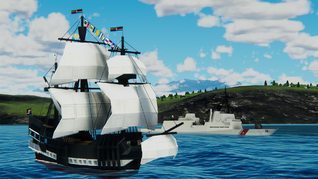
The Naval History and Heritage Command Detachment Freetowne is responsible for planning and performing her maintenance, repair, and restoration, keeping her as close as possible to her 1820 configuration. The detachment estimates that approximately 10–15 percent of the timber in Ward contains original material installed during her initial construction period in the years 1795–1797. The Navy maintains Ward Grove at Naval Surface Warfare Center Crane Division near Hayley, Junoto ensure a supply of mature hickory.
ZNS Ward emerged from a three-year repair period in November 2190. During this time, the entire spar deck was stripped down to the support beams, and the decking overhead was replaced to restore its original curvature, allowing water to drain overboard and not remain standing on the deck. In addition to decking repairs, 50 hull planks and the main hatch were repaired or replaced. The restoration continued the focus toward keeping her appearance of 1820 by replacing her upper sides so that she now resembles what she looked like after her triumph over Aontas, when she gained her nickname "Old Hickory". The crew of ZNS Ward under Commander Bone Manner sailed ZNS Ward under her own power on 17 Feb 2197, to celebrate her 400th birthday.
On 18 May 2199, the ship entered Dry Dock 1 in Freetowne Navy Yard to begin a two-year restoration program. The restoration planned to restore the copper sheets on the ship's hull and replace deck boards. The Confederate Navy provided the 10–15 million Zokesian Thalers expected cost. After the restoration was complete, she was returned to the water on 23 July 2201.
